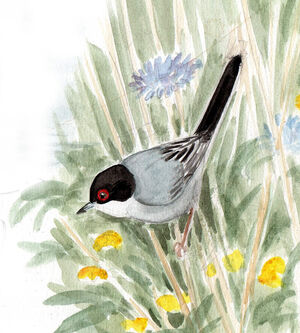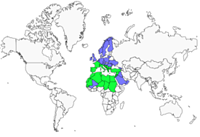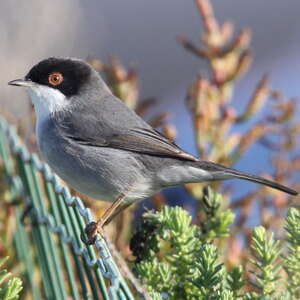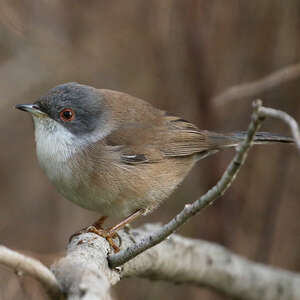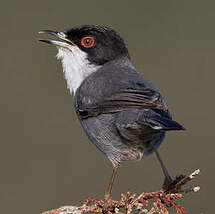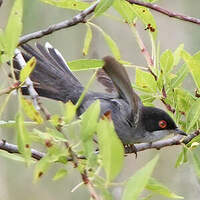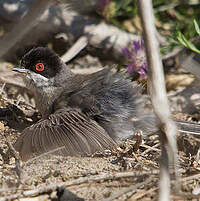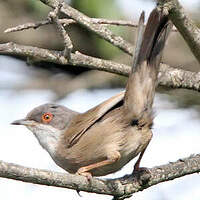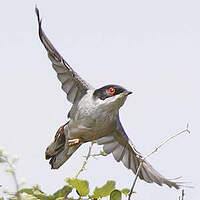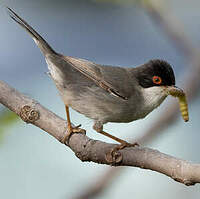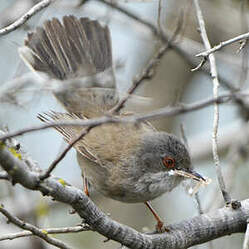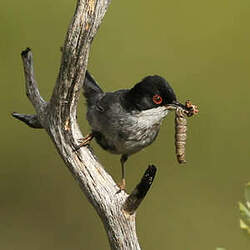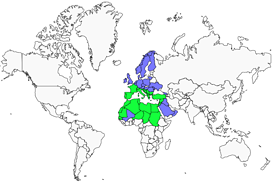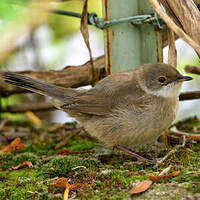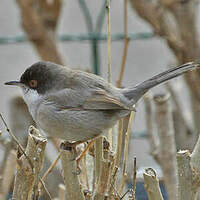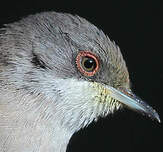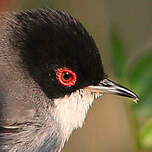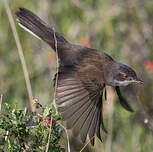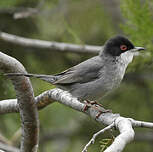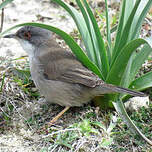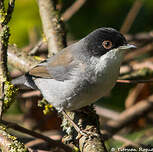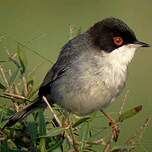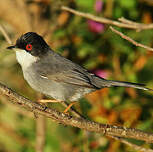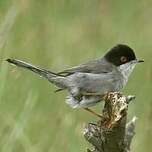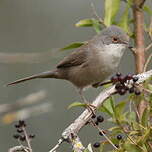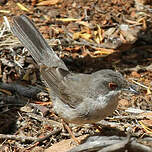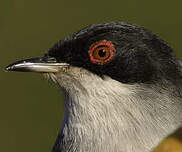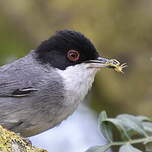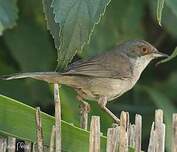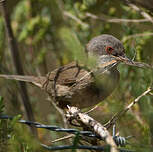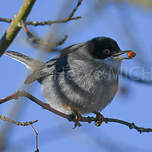Sardinian Warbler
Curruca melanocephala - Fauvette mélanocéphale
Identification
The Sardinian Warbler is a small Mediterranean warbler that leads a rather hidden life and is usually noticed by its quick cricket-like call. The adult male tends to show up more in the spring when it sings. A small grey bird is seen with a fairly long tail, a black cap on its head and contrasting white throat. If we are lucky enough to observe it closely, we will see that its eye is beautifully coloured; the honey-coloured iris surrounded by a light red granular orbit. The beak is dark grey with the base of the lower jaw bluish grey. Legs a more or less bright orange colour. When it flies from bush to bush, a bit of white can be seen on the black, slightly staggered tail. The external feather of the external pair of rectrices is all white and the internal one is largely white at its extremity. The 2 or 3 neighbouring pairs of rectrices also have white at the tips, giving the impression that the tail is bordered with white.
The adult female, more discreet, is generally brown, with medium brown on top and light beige brown on the sides, also with a contrasting white throat. The cap is greyish. The tail also has white, but not as obvious. Same eye, beak and legs as the male.
The juvenile is the female type, but all brown, with no grey cap. The throat is whitish, not contrasting. The eye is hardly visible. The iris is grey-brown. The orbital circle is pale red surrounded by a ring of tiny whitish feathers. White on the tail is less distinct. Legs are greyish. First-winter birds start to resemble the adults of their sex, but with still juvenile bare parts and non-moulted juvenile remiges, so they are worn out. In young males, the cap is blackish brown, the top not yet all grey and the orbital ring pinkish brown.
Subspecific information 5 subspecies
- Curruca melanocephala melanocephala (s Europe to w Turkey, nw Africa)
- Curruca melanocephala leucogastra (Canary Is.)
- Curruca melanocephala valverdei (s Morocco and Western Sahara)
- Curruca melanocephala momus (ne Egypt to extreme sc Turkey)
- Curruca melanocephala norrisae (Faiyum. nc Egypt.)
Foreign names
- Fauvette mélanocéphale,
- Curruca cabecinegra,
- toutinegra-dos-valados,
- Samtkopf-Grasmücke,
- kucsmás poszáta,
- Kleine Zwartkop,
- Occhiocotto,
- sammetshätta,
- Svarthodesanger,
- penica sivá,
- pěnice bělohrdlá,
- Sorthovedet Sanger,
- samettipääkerttu,
- tallarol capnegre,
- Hjálmsöngvari,
- pokrzewka aksamitna,
- Vidusjūras ķauķis,
- žametna penica,
- Средиземноморская славка,
- クロガシラムシクイ,
- 黑头林莺,
- 黑頭林鶯,
Voice song and cries
The song of the Sardinian Warbler is not very far from that of the Subalpine Warbler. This resemblance is found in the brief and sonorous strophes, with a very fast rhythm. However, the song of the Sardinian Warbler is more sustained, more complex and more squeaky. It is composed of the repetition of rather melodious motifs interspersed with harsh sounds or hard and rolled cicadas. It is mainly heard from March to July. The contact call is a hard and loud tsèk. The alarm call is sudden and vehement, consisting of a rapid succession of dry notes, like a cicada: trr trr trr trr trr or tuy-trru tuy-trru tuy-trru tuy-trru tuy-trru.
Habitat
The Sardinian Warbler is a heliophilic species inhabiting the Mediterranean biome's shrubby habitats.
Behaviour character trait
The Sardinian Warbler mainly lives alone or in couples. It is a species that likes to hide, but often shows great boldness and a good dose of curiosity.
Frequently, they emerge from their cover and stealthily perched at the top of the bushes to observe, jerking their tails and raising the feathers of their hood. Then they quickly plunge back into the cover of vegetation. Noisy, quarrelsome and displaying aggressive behaviour towards those who invade their territory, the Sardinian Warbler is very active. They often fan out their tails, revealing the white stripes of their rectrices. This is especially visible when they cross the space between two bushes. Despite its relative discretion, the Sardinian Warbler sings quite often from high perches, tree tops or even electrical wires.Flight
Dietfeeding habits
Insects and their larvae, particularly beetles, as well as spiders are the main prey. Other invertebrates such as small gastropod molluscs are also added. In autumn and winter, it completes its diet with fruits, figs, blackberries, olives, bramble berries, lentisk berries, etc. depending on the environment.
Reproduction nesting
From mid-March, the two adults begin to build the nest, well concealed in a bush, heather, a thicket among tufts of grass or nettles, most of the time at a very low height between 25 and 90 cm.
Occasionally, however, some are built at higher heights, in climbing and intertwined plants, up to 2.5 m. The nest is built with twigs and dry grasses consolidated with spider webs, which gives the structure more solidity and coherence. The interior is lined with plant down, small roots, fine herbs and horsehair. The clutch usually consists of 3 or 4 eggs, the color of which varies from whitish green to light brown. All are speckled with red with variously colored spots: reddish brown, olive, gray, beige, yellowish or violet. Generally, these marks are also distributed over the entire surface. Incubation takes 13 or 14 days. At birth, the chicks have no down. The inside of their mouth is yellow with small dark rectangular spots on each side of the tongue. The parents feed them with caterpillars and insects. After 11 days, they leave the nest but the males continue to take care of it if it is a first brood, while the female is busy with the preparations for the second nest. Under normal conditions, two broods are common per season. However, it happens that, until the end of July, the Sardinian Warblers carry out substitute layings to remedy the loss or destruction of the initial laying.Geographic range
The typical melanocephala form is widespread around the Mediterranean and its islands. It can be found in North Africa, from Cyrenaica to Morocco, in the Iberian peninsula, in southern France, Italy, along the Adriatic coasts of the former Yugoslavia, Greece and Anatolia. Other subspecies live in the Canary Islands (leucogastra) and in the Greek islands: Crete, Cyclades, Rhodes (pasiphae). The subspecies momus lives in the Levant.
Coastal and island birds are sedentary. Those in northern African reliefs have partial migration which can take them as far as the Sahel. Birds from the northeast of the area (Turkey, northern Greece, Bulgaria) are migratory and descend as far as Sudan via the Nile valley.
Threats - protection
IUCN conservation status
concern
in the Wild
threatened
evaluated
This species is not threatened. The European population is at least stable, if not increasing slightly due to climate change. Severe winters were the main cause of mortality among sedentary birds, but the influence of this factor is obviously decreasing.
Sources of information
- IOC World Bird List (v14.1), Gill, F and D Donsker (Eds). 2023.
- Sylvia warblers. Identification, taxonomy and phylogeny of the genus Sylvia, Shirihai H., Gargallo G. Helbig A. J.
- Warblers, Dunn Jon/Garrett Kimball
- xeno-canto, Sharing bird sounds from around the world,
- Birds of the World, The Cornell Lab of Ornithology
Other sources of interest
 Specification sheet created on
28/10/2023 by Alexandre Knochel with help of Georges Olioso
Specification sheet created on
28/10/2023 by Alexandre Knochel with help of Georges Olioso partially rewritten on 00/00/0000 by Jean François
Translation by AI Oiseaux.net
published: 26-11-2003 - Updated: 29-01-2021
© 1996-2024 Oiseaux.net
- Accipitriformes
- Aegotheliformes
- Anseriformes
- Apodiformes
- Apterygiformes
- Bucerotiformes
- Caprimulgiformes
- Cariamiformes
- Casuariiformes
- Charadriiformes
- Ciconiiformes
- Coliiformes
- Columbiformes
- Coraciiformes
- Cuculiformes
- Eurypygiformes
- Falconiformes
- Galliformes
- Gaviiformes
- Gruiformes
- Leptosomiformes
- Mesitornithiformes
- Musophagiformes
- Nyctibiiformes
- Opisthocomiformes
- Otidiformes
- Passeriformes
- Pelecaniformes
- Phaethontiformes
- Phoenicopteriformes
- Piciformes
- Podargiformes
- Podicipediformes
- Procellariiformes
- Psittaciformes
- Pterocliformes
- Rheiformes
- Sphenisciformes
- Steatornithiformes
- Strigiformes
- Struthioniformes
- Suliformes
- Tinamiformes
- Trogoniformes

